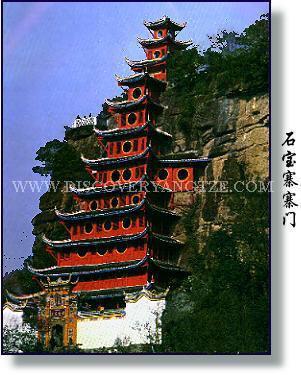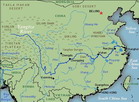2020 Yangtze River Cruise and Ferry Starting from 79 USD p.p.!
Zhongxian introduction
There are two moving stories about
how Zhongxian (Loyal County) got its name. In
the  Warring
States period (475--22l BC), Ba Manzi, a native
of Zhongxian, became a general to the army of
the Kingdom of Ba. Towards the end of the Zhou
dynasty tile Kingdom of Ba was in a state of
civil war, and Ba Manzi was sent to the Kingdom
of Chu to beg military assistance to put down
the rebellion. The price demanded by Chu was
the forfeit of three Ba cities. Once Chu's troops
had helped restore stability to Ba, the King
of Chu sent his minister to demand the payoff.
Ba Manzi, however, said f 'Though I promised
Chu the cities you will take my head in thanks
to the King of Chu, for the cities of Ba cannot
be given away', whereupon he cut off his own
head. Receiving his minister's account, the
King of Chu sighed f 'Cities would count as
nothing had I loyal ministers like Ba Manzi'.
He then ordered that Ba Manzi's head be buried
with full honours.
Warring
States period (475--22l BC), Ba Manzi, a native
of Zhongxian, became a general to the army of
the Kingdom of Ba. Towards the end of the Zhou
dynasty tile Kingdom of Ba was in a state of
civil war, and Ba Manzi was sent to the Kingdom
of Chu to beg military assistance to put down
the rebellion. The price demanded by Chu was
the forfeit of three Ba cities. Once Chu's troops
had helped restore stability to Ba, the King
of Chu sent his minister to demand the payoff.
Ba Manzi, however, said f 'Though I promised
Chu the cities you will take my head in thanks
to the King of Chu, for the cities of Ba cannot
be given away', whereupon he cut off his own
head. Receiving his minister's account, the
King of Chu sighed f 'Cities would count as
nothing had I loyal ministers like Ba Manzi'.
He then ordered that Ba Manzi's head be buried
with full honours.
The second tale is of another man
of Zhongxian, the valiant general Yan Yan, who
Served the Minor Han dynasty (AD 221--63). Captured
by the Shu general Zhang Fei, he refused to
surrender, saying boldly f 'In my country we
had a general who cut off his own head but we
do not have a general who surrendered'. Enraged,
Zhang Fei ordered Yan's beheading. The doomed
general remained perfectly calm as he asked
simply, 'Why are you so angry? lf you want to
cut off my head then give the order, but there
is no point in getting angry and upsetting yourself.'
Zhang Fei was so deeply moved by Yan's loyalty
and bravery in the face of death that he personally
unbound him, treating him as an honored soldier.
Traditionally, the thick bamboo
hawsers used to haul junks over the rapids were
made in this area, as the local bamboo is especially
tenacious. Today, bamboo handicrafts are a thriving
industry, while the local food specialty is
ZhongXian beancurd milk.
Shibaozhai
Shibaozhai represents the first
gem of Chinese architecture to be encountered
on the downstream journey. From afar, the protruding
220-metre (720-foot) hill on the north bank
can appear to resemble a jade seal, and is so
named. The creation of the hill is attributed
to the goddess Nuwo, who caused a rock slide
while she was redecorating the sky after a fierce
battle between two warring dukes.
A red pavilion hugs one side of
this rock. lts tall yellow entrance gate is
decorated with lions  and
dragons and etched with an inscription inviting
the visitor to climb the ladder and ascend into
a 'Little Fairyland'. The temple at the top
was built during the reign of Emperor Qianlong
(1736--96) and access to it was by an iron chain
attached to the cliff. A nine-storeyed wooden
pavilion was added in 1819 so that monks and
visitors to the temple would not have to suffer
the discomforts of the chain ascent. In 1956
three more storeys were added. Each floor is
dedicated to famous generals of the Three Kingdoms
period (AD 220--65), local scholars and
and
dragons and etched with an inscription inviting
the visitor to climb the ladder and ascend into
a 'Little Fairyland'. The temple at the top
was built during the reign of Emperor Qianlong
(1736--96) and access to it was by an iron chain
attached to the cliff. A nine-storeyed wooden
pavilion was added in 1819 so that monks and
visitors to the temple would not have to suffer
the discomforts of the chain ascent. In 1956
three more storeys were added. Each floor is
dedicated to famous generals of the Three Kingdoms
period (AD 220--65), local scholars and
renowned Chinese poets. The rising waters of
the river will eventually surround the pagoda,
which will be preserved with a tiny dam of its
own, but left on an island.
In front of Ganyu Palace at the
top of Jade Seal Hill is the Duck Hole. It is
said that as spring turns to summer, if you
take a live duck and drop it through the hole,
it will quickly reappear swimming in the Yangtze.
In the past the monks apparently drew their
drinking water from this hole by using a pipe
made of bamboo.
The spirit wall in the temple's
main hall is constructed of excavated Han-dynasty
(206 BC--AD 220) bricks. The hall behind is
dedicated on the right to Generals Zhang Fei
and Yan Yan (see above and page 42) of the Three
Kingdoms, and on the left to General Qin Liangyu
(1576--l648) who fought bravely against the
Manchu forces. A mural shows the goddess Nuwo
repairing the sky. In the rear hall are the
remains of the Rice Flowing Hole. Legend has
it that long ago just enough husked rice would
flow up from the small hole each day for the
needs of the monks and their guests. One day
a greedy monk, thinking he could become rich,
chiselled a bigger hole, and the rice flow ceased
forever.
Many of the tourist cruise ships
dock at Shibaozhai for a few hours' visit. For
those on scheduled passenger boats, you should
disembark at Xituozhen on the south bank and
transfer to local ferries to cross the river.
The new village of Shibaozhai is
located above the present town which will be
submerged by the end of 2002.



